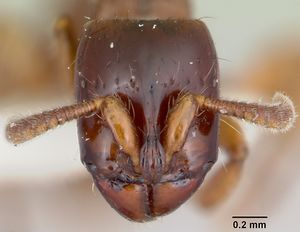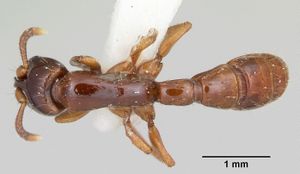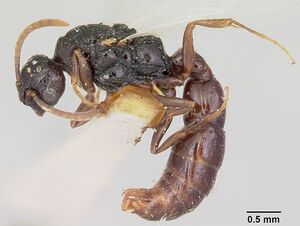Acanthostichus texanus
| Acanthostichus texanus | |
|---|---|

| |
| Scientific classification | |
| Kingdom: | Animalia |
| Phylum: | Arthropoda |
| Class: | Insecta |
| Order: | Hymenoptera |
| Family: | Formicidae |
| Subfamily: | Dorylinae |
| Genus: | Acanthostichus |
| Species: | A. texanus |
| Binomial name | |
| Acanthostichus texanus Forel, 1904 | |
| Synonyms | |
| |
This species is primarily subterranean and preys on termites (Gnathamitemrmes tubiformans). One method of finding workers involves looking under cow manure pats, where they may be preying on termites. Workers have most commonly been found in the autumn and winter (October through December). Two males were collected in May and November 1987 at 13:30 (D. Gonzalez, pers. comm.). Two workers were collected in the soil when D. Gonzalez was excavating a Pogonomyrmex barbatus nest (pers. comm.). (As reported in MacKay 1996.)
Identification
A member of the texanus species complex. Mackay (1996) - All three castes of this species are easily distinguished from those of the other species. The workers are easily distinguished from all other known species by the relatively large eye and the top of the petiole is smooth and strongly shining (found in few other species). Workers of Acanthostichus emmae would be expected to have a more quadrate petiole than those of A. texanus, but would otherwise be expected to be similar. The female is easily distinguished as it is one of the few in the genus that would have wings. They are not subdichthadiiform as in other species and are actually very similar to the workers, both in size and form. The top of the petiole is smooth and the petiole is elongate. The female is similar to that of A. emmae, but has a narrower head, narrower petiole and smaller ocelli and is thus easily separated. The male is similar to those of other species in the genus, except for the genitalia, which are very distinct, and it has a 13 segmented antenna. The teeth of the subgenital plate are thickened, which easily and conveniently separates this species from all other known males. The males of A. emmae would be expected to be similar, but may have petiolar nodes much more quadrate than those of A. texanus. The males of A. texanus have not been associated with workers, but these three castes are probably all members of the same species. All three castes are quite different from those of other species, it is the only species collected from the area around Monterrey, Mexico, and the petioles of the three castes are polished and shining. There is little doubt they are conspecific. Males have petioles of two forms, but are assumed to be a single species.
Keys including this Species
Distribution
Known from northeastern Mexico (Nuevo Leon) and southeastern Texas (Brownsville).
Latitudinal Distribution Pattern
Latitudinal Range: 32.598628° to 20.937229°.
| North Temperate |
North Subtropical |
Tropical | South Subtropical |
South Temperate |
- Source: AntMaps
Distribution based on Regional Taxon Lists
Nearctic Region: United States (type locality).
Neotropical Region: Mexico.
Distribution based on AntMaps
Distribution based on AntWeb specimens
Check data from AntWeb
Countries Occupied
| Number of countries occupied by this species based on AntWiki Regional Taxon Lists. In general, fewer countries occupied indicates a narrower range, while more countries indicates a more widespread species. |

|
Estimated Abundance
| Relative abundance based on number of AntMaps records per species (this species within the purple bar). Fewer records (to the left) indicates a less abundant/encountered species while more records (to the right) indicates more abundant/encountered species. |

|
Biology
Castes
Worker
Images from AntWeb
   
| |
| Worker. Specimen code casent0105578. Photographer April Nobile, uploaded by California Academy of Sciences. | Owned by USNM, Washington, DC, USA. |
Queen
Images from AntWeb
     
| |
| Worker. Specimen code casent0103130. Photographer April Nobile, uploaded by California Academy of Sciences. | Owned by USNM, Washington, DC, USA. |
Male
Images from AntWeb
     
| |
| Type of Acanthostichus texanus. Male (alate). Specimen code casent0103131. Photographer April Nobile, uploaded by California Academy of Sciences. | Owned by USNM, Washington, DC, USA. |
Nomenclature
The following information is derived from Barry Bolton's Online Catalogue of the Ants of the World.
- texanus. Acanthostichus texanus Forel, 1904d: 168 (q.) U.S.A. (Texas).
- Type-material: holotype queen.
- Type-locality: U.S.A.: Texas, Brownsville (Wickham).
- Type-depository: MRHN.
- Mackay, 1996: 168 (w.).
- Combination in Acanthostichus (Ctenopyga): Emery, 1911d: 14;
- combination in Ctenopyga: Brown, 1975: 42;
- combination in Acanthostichus: Mackay, 1996: 168.
- Status as species: Wheeler, W.M. 1908e: 400; Wheeler, W.M. 1910g: 561; Emery, 1911d: 14; Creighton, 1950a: 59; Smith, M.R. 1951a: 782; Smith, M.R. 1955a: 49; Smith, M.R. 1955b: 99; Smith, M.R. 1958c: 110; Kusnezov, 1962a: 133; Smith, M.R. 1967: 345; Brown, 1975: 42; Smith, D.R. 1979: 1334; Bolton, 1995b: 54; Mackay, 1996: 168 (redescription).
- Senior synonym of townsendi: Smith, M.R. 1955a: 49; Smith, M.R. 1955b: 99; Smith, M.R. 1958c: 110; Brown, 1975: 42; Smith, D.R. 1979: 1334; Bolton, 1995b: 54; Mackay, 1996: 168.
- Distribution: Mexico, U.S.A.
- townsendi. Ctenopyga townsendi Ashmead, 1906: 29, fig. 4 (q.m.) MEXICO (no state data).
- Type-material: lectotype male (by designation of Mackay, 1996: 170).
- [Note: original type-series consisted of 1 syntype queen, 2 syntype males, initially deposited in USNM. The male currently in MCZC (lectotype) now appears to be the only extant specimen (Mackay, 1996: 170).]
- Type-locality: Mexico: La Puerta, 6.v.1895 (C.H.T. Townsend).
- Type-depository: MCZC (lectotype).
- Combination in Acanthostichus (Ctenopyga): Emery, 1911d: 14.
- Status as species: Emery, 1911d: 14; Kusnezov, 1962a: 133.
- Junior synonym of texanus: Smith, M.R. 1955a: 49; Smith, M.R. 1955b: 99; Smith, M.R. 1958c: 110; Brown, 1975: 42; Smith, D.R. 1979: 1334; Bolton, 1995b: 54; Mackay, 1996: 168.
Unless otherwise noted the text for the remainder of this section is reported from the publication that includes the original description.
Mackay (1996):
Description
Worker
HL 0.94 - 1.06, HW 0.83 - 0.96, SL 0.43 - 0.48, SW 0.15 - 0.18, EL 0.05 - 0.08, WL 1.39 - 1.56, FL 0.65 - 0.70, FW 0.28 - 0.33, PW 0.38 - 0.48, PL 0.48 - 0.54, SI 44 - 45, C186 - 93, PI 113 - 130, FI 2.15 - 2.36, SL/ SW 2.64 - 2.92. Mandibles without teeth, but angulate at apex; anterior border of clypeus notched, frontal carinae forming angles which extend past anterior medial border; vertex broadly concave, sides nearly parallel, slightly convex; eyes relatively large, consisting of about 10 poorly defined ommatidia; anterior border of scape weakly concave; mesosoma similar to those of other members of the genus; propodeum not concave posteriorly, lacking spines or teeth; petiole wider posteriorly than anteriorly; subpetiolar process large, well developed, anterior edge broadly rounded, posterior edge broadly concave, faces meeting at distinct angle (Fig. 42); gaster as in other species, pygidium toothed. Hairs long (0.25 mm), erect, pointed and on all surfaces; entire ant devoid of decumbent pubescence. Dark reddish brown, smooth and polished throughout.
Queen
HL 0.95- 1.24, HW 0.84 - 1.03, SL 0.43 - 0.51, SW 0. 15 - 0. 19, EL 0.23 - 0.29, WL 1.65 - 1.88, PW 0.40 - 0.60, PL 0.53 - 0.64, SI 41 - 45, CI 83 - 88, PI 106 - 131, SL/SW 2.73 - 2.92. Mandible essentially toothless, except for very fine serration in one specimen; clypeus with very small lateral bumps; eyes large, reaching side of head in full face view; ocelli small (diameter of median ocellus 0.06 mm); scape very slightly concave anteriorly; sides of head nearly parallel; vertex slightly concave; mesosoma little modified for flight; posterior face of propodeum concave; petiolar node elongate, widened posteriorly, All surfaces with abundant erect hairs, decumbent pubescence limited to parts of mesonotum near base of wings, descending face of propodeum and anterior face of petiole. Sculpture is shining and polished, color is dark reddish brown.
Male
(Measurements of Ctenopyga townsendi lectotype in parentheses): HL 0.83 - (0.85), HW (posterior to eye) (0.78) - 0.80, SL (0.24) - 0.28, SW (0.1) 0.1, EL (0.35) - 0.39, WL (1.79) - 1.85, PW (0.43) - 0.44, PL (0.49) - 0.54. Indices: SI (28) - 34, CI (92) - 96, PI (1 14) - 123. Mandible without teeth, apex angled; median anterior border of clypeus broadly convex; eyes large, convex; 3 well developed ocelli, diameter less than distance between them; antennae 13 segmented, sides of scape parallel, anterior edge not concave; vertex of head convex; posterior face of petiole broadly concave, petiole shaped as in worker, elongate, wider posteriorly, subpetiolar process shaped as in worker, but not as wide. Genitalia unusual for the genus. Parameres large with long slender shaft, hairy apex which is hook-like, pointed ventrally and posteriorly; aedeagus very distinctive, consists of elongate process which terminates in triangular shaped, toothed structure; volsellae large with round lobe; subgenital plate distinctive, terminating in two broad teeth (Fig. 77). Hairs covering entire surface, most about 0.1 mm long, few up to 0.25 mm, lacking decumbent pubescence. Sculpture mostly smooth, shining, mandibles and head shagreened or finely punctate. Very dark brown in color, mandibles, funiculus, legs, genitalia lighter brown.
Type Material
Dealate female. USA: Texas. Brownsville. H. F. Wickham (Musee d'Histoire Naturelle Genève) [not seen. presumably lost, see Smith. 1955].
References
- Alatorre-Bracamontes, C.E., Vásquez-Bolaños, M. 2010. Lista comentada de las hormigas (Hymenoptera: Formicidae) del norte de México. Dugesiana 17(1): 9-36.
- Brown, W. L., Jr. 1975. Contributions toward a reclassification of the Formicidae. V. Ponerinae, tribes Platythyreini, Cerapachyini, Cylindromyrmecini, Acanthostichini, and Aenictogitini. Search Agric. (Ithaca N. Y.) 5(1 1: 1-115 (page 42, Combination in Ctenopyga)
- Cantone S. 2017. Winged Ants, The Male, Dichotomous key to genera of winged male ants in the World, Behavioral ecology of mating flight (self-published).
- Cantone S. 2018. Winged Ants, The queen. Dichotomous key to genera of winged female ants in the World. The Wings of Ants: morphological and systematic relationships (self-published).
- Emery, C. 1911e. Hymenoptera. Fam. Formicidae. Subfam. Ponerinae. Genera Insectorum 118: 1-125 (page 14, Combination in Acanthostichus (Ctenopyga))
- Forel, A. 1904e. Fourmis du Musée de Bruxelles. Ann. Soc. Entomol. Belg. 48: 168-177 (page 168, queen described)
- Mackay, W.P. 1996. A revision of the ant genus Acanthostichus. Sociobiology 27: 129-179. [(31.xii).1996.]
- Rojas Fernández, P. 2001. Las hormigas del suelo en México: diversidad, distribución e importancia (Hymenoptera: Formicidae). Acta Zoológica Mexicana (n.s.)1(número especial):189-238.
- Smith, M. R. 1955b. Acanthostichus (Ctenopyga) townsendi (Ashm.), a synonym of Acanthostichus texanus Forel (Hymenoptera: Formicidae). Bull. Brooklyn Entomol. Soc. 50: 48-50 (page 49, Senior synonym of townsendi)
- Wheeler, G. C. and J. Wheeler. 1985a. A checklist of Texas ants. The Prairie Naturalist 17(2): 49-64.
- Wheeler, W. M. 1908h. The ants of Texas, New Mexico and Arizona. (Part I.). Bull. Am. Mus. Nat. Hist. 24: 399-485.
References based on Global Ant Biodiversity Informatics
- Brown W. L., Jr. 1975. Contributions toward a reclassification of the Formicidae. V. Ponerinae, tribes Platythyreini, Cerapachyini, Cylindromyrmecini, Acanthostichini, and Aenictogitini. Search Agric. (Ithaca N. Y.) 5(1): 1-115.
- Fernandes, P.R. XXXX. Los hormigas del suelo en Mexico: Diversidad, distribucion e importancia (Hymenoptera: Formicidae).
- LeBrun E. G., R. M. Plowes, and L. E. Gilbert. 2015. Imported fire ants near the edge of their range: disturbance and moisture determine prevalence and impact of an invasive social insect. Journal of Animal Ecology,81: 884–895.
- MacKay W. P. 1996. A revision of the ant genus Acanthostichus (Hymenoptera: Formicidae). Sociobiology 27: 129-179
- O'Keefe S. T., J. L. Cook, T. Dudek, D. F. Wunneburger, M. D. Guzman, R. N. Coulson, and S. B. Vinson. 2000. The Distribution of Texas Ants. The Southwestern Entomologist 22: 1-92.
- Smith M. R. 1936. A list of the ants of Texas. Journal of the New York Entomological Society 44: 155-170.
- Smith M. R. 1955. Acanthostichus (Ctenopyga) townsendi (Ashm.), a synonym of Acanthostichus texanus Forel (Hymenoptera: Formicidae). Bulletin of the Brooklyn Entomological Society 50: 48-50.
- Vasquez-Bolanos M. 2011. Checklist of the ants (Hymenoptera: Formicidae) from Mexico. Dugesiana 18(1): 95-133.
- Vásquez-Bolaños M. 2011. Lista de especies de hormigas (Hymenoptera: Formicidae) para México. Dugesiana 18: 95-133
- Wheeler, G.C. and J. Wheeler. 1985. A checklist of Texas ants. Prairie Naturalist 17:49-64.

